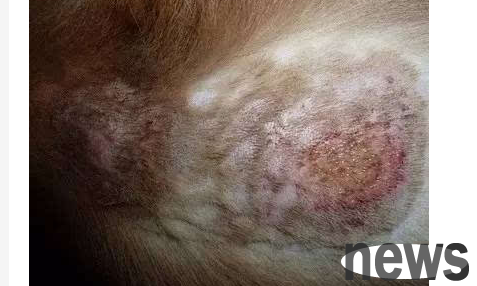Popular Science: Basic knowledge about dog allergies
The continuous rainy weather is finally over, and the weather is finally getting warmer. I took the dog out for spring while the spring flowers are in full bloom, but I found that the dog has skin allergies. Why is this? Do dogs also become allergic to pollen like humans? Do dogs have other allergic symptoms?

Common allergic symptoms in dogs
1. Constant itching of the body
Pet Knowledge: Cats and dogs live in the same room, what should parents pay attention to? Skin allergic symptoms: The dog's body will be very itchy. Their itchy places are usually in their nose, belly, toes, etc. They will constantly scratch their bodies, and may see erythema on the belly, hair falls off, epidermis or ulcers, and even more serious skin symptoms.
Skin allergies may also cause symptoms of redness, swelling and inflammation of the lips, eyelids, and conjunctiva.
2. Causes shortness of breath
Respiratory allergic reaction: Dogs will experience shortness of breath, sneezing, coughing, easily feel anxious, and their emotions will become unstable.
3. Diarrhea and abdominal pain
Gastrointestinal allergic symptoms: mainly water diarrhea and vomiting after eating, mild inflammation of the intestine, severe hemorrhagic colitis, and bloody stools.
causes of dog allergies:
The antigen that induces allergic reactions in dogs is called allergens. There are 2,000-3,000 common antigenic substances that cause allergic reactions, and nearly 20,000 medical records are recorded. Common allergens (note: the following may cause allergic reactions in dogs, not necessarily, and not all dogs) and specific reactions:
1. Inhaled allergens: such as pollen, catkins, dust, mites, animal dander, oil smoke, paint, car exhaust, gas, cigarettes, etc.
2. Ingested allergens: such as specific proteins, eggs, fish, shrimps, beef and mutton, seafood, animal fat, allogeneic protein, alcohol, drugs, antibiotics, anti-inflammatory drugs, sesame oil, essence, onion, ginger, garlic, and some vegetables and fruits.
3. Contact allergens: such as cold air, hot air, ultraviolet rays, radiation, cosmetics, shampoo, dishwash, hair dye, soap, chemical fiber supplies, plastic, metal jewelry (watches, necklaces, rings, earrings), bacteria, mold, viruses, parasites, etc.
4. Injectable allergens: such as penicillin, streptomycin, heterogeneous serum, etc. Penicillin is the first drug that causes drug allergies in dogs and cats; the others are sulfonamide drugs, greyofomycin, cytosine and sulfadimethylisoxazole.
5. Self-tissue antigen: Self-tissue antigen that changes structure or composition due to biological and physical and chemical factors such as mental stress, work pressure, and changes in structure or composition due to biological and physical and chemical factors such as microbial infection, ionizing radiation, and burns.
Coping methods for dog allergies
1, reducing allergies can be of great or minor severity, and a slight desensitization injection can be given, while severe allergies may directly threaten the dog's life safety. Severe allergic symptoms or allergies caused by drugs or other allergies must be treated as soon as possible.
For symptoms of skin allergies, you can use medicinal bath lotion such as Minfukang. Medicinal bathing on your pet can effectively reduce the symptoms of their reactions. Allergens are checked and isolated. Basically, all dogs have their own allergens. It is very important to check which ingredient causes allergies to dogs. Elimination methods can be used in terms of food. If it is impossible to test which ingredient is causing pets to allergize, veterinarians may design allergen tests for dogs, or allergen tests, which many hospitals have been able to do. After finding an allergen for the dog, the owner should try not to let the dog touch these things, so as to avoid the occurrence of allergic reactions to the greatest extent.

3, prevent the recurrence of allergies
, correspond to various possible allergic reactions in the environment. We can adjust them from aspects such as living habits:
A. Maintain good hygiene habits. The indoor should be ventilated frequently, which can effectively reduce the amount of dust in the room. For dogs who may be allergic to ectoparasites, they must do regular deworming.
B. Choose products that are not prone to allergies. Try to choose materials that are not easy to penetrate and avoid materials that are prone to dust and debris, such as cloth curtains, bedding and carpets. Sofa covers, bedding, curtains, dog's nests and toilets should be changed regularly. Using a mini filter on a vacuum cleaner can clean up allergens more efficiently.
C. Comb the dog's hair so that the combed dandruff and hair can be left outside to ensure the clean and hygienic of the indoor environment.
D. Take a bath for your dog regularly, and the dog carries no less allergen than the outside world. Studies show that it is more effective to bathe dogs regularly. An allergy and asthma expert in the United States believes that under normal circumstances, companion animals should bathe at no more than once every 10 days.
E. Immunotherapy can relieve symptoms. Doctors try to reduce the sensitivity of the patient's immune system to animals, use minoxidil probiotics to stimulate the body to produce antibodies, lock in allergens, and reduce or avoid allergic reactions.
Allergic symptoms are actually not far from dogs. Genetic defects caused by improper breeding and improper breeding methods are making the probability of allergic symptoms increasingly higher. Maintain good pet-keeping habits. Even if you encounter suspected allergic symptoms, contact your pet doctor in time to deal with them effectively. Allergic symptoms are not scary.




